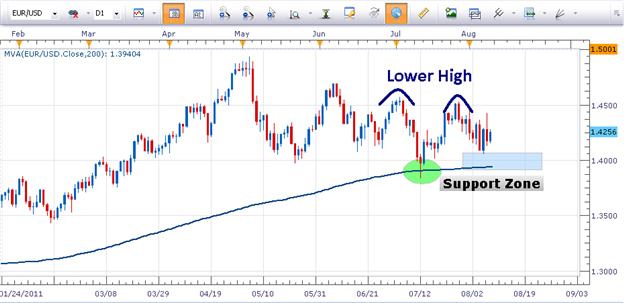Volatility is on the rise in stocks as the economic outlook is questioned on the heels of a US debt downgrade. EURUSD volatility is surpassing levels not seen since June 2010. When the market gets volatile as we have seen lately, one way to trade it is with a breakout type of strategy.
The Mechanics of a Breakout
Analyze a chart and determine the mood of the market, or trend direction. In the case of the EURUSD, the risk aversion has been contagious lately. Additionally, after finding support at the 200 day Simple Moving Average, prices have failed to create a higher high. Therefore, we will look for and filter for sell trades.
In a selling opportunity, identify levels of support and anticipate a break below support. In a buying market, identify levels of resistance and anticipate a break above resistance. Since we are filtering for sell trades, we are going to identify support and place a trade based on a breakdown through support.

The benefit of breakout trades is that they do not require any indicators on your chart. Take a clean chart and identify levels of support. I have included the 200 day Simple Moving Average (blue line) as that is often used by large institutions as a level of support. Horizontal support rests at the low of Friday’s candle (1.4055). Additionally, the 200 SMA is nearby at 1.3940. This congestion zone of 1.3940 to 1.4055 will likely provide at a minimum temporary support for prices should they fall further.
The Entry and Stop Loss
Place an entry order to sell 1 pip below the support level or at 1.3940.
When identifying our stop placement, scale down to a smaller time frame chart (between 1hr and 4hr time frame). Place the stop loss just above the swing high in this case because we are creating a sell entry order. Now, take twice the distance of your stop loss and project that from your entry point for a take profit level.
One of the important rules of trade management we discuss inside the DailyFX EDU webinars is risking less than 5% of your account on all open trades. ( Here is a short video on Money Management of trades. )
The benefit of a breakout type of strategy is that we can be wrong on the trading idea, meaning the price of the EURUSD can move straight higher from here, yet we miss out on a losing trade. As a trader, not only do I want to enter into winning trades, but I also want to be kept out of losing trades. A breakout style of trading can help navigate volatile waters and keep you out of some losing trades.
Additional Educational Resources
How to Trade with Support and Resistance Part 1
How to Trade Trend Line Support and Resistance – Part 2
Also, join me tomorrow at 13:00 GMT (9am ET) at the DailyFX Trading Room for a live webinar on trading the USDollar. This is an opportunity to discuss the current market events and ways to trade it on the USDollar. Ask your questions in real time.
I look forward to seeing you there!
Jeremy Wagner contributes to the Instructor Trading Tips articles.
http://www.dailyfx.com/how_to_trade_forex/course_trading_tips




